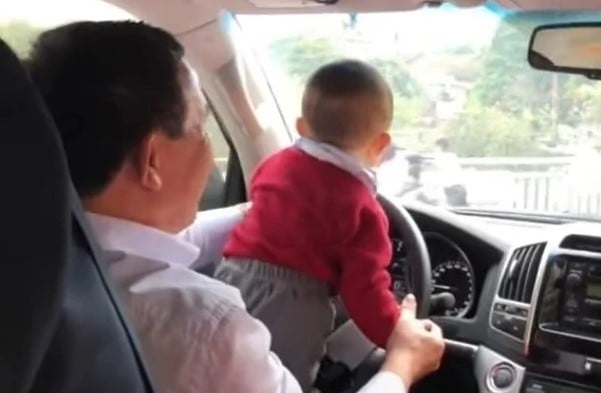Vietnam currently has no regulations on the use of child safety devices in cars. This is a legal “gap” that needs to be filled in the near future to better protect children.
 |
| Letting children sit in the front seat of a car and play around is very dangerous. (Source: vov.vn) |
"Gap" in regulations on child safety equipment
Statistics show that in Vietnam, in the past 10 years, the death rate due to traffic accidents among children has decreased, but is still very high. Every year, about 2,000 children die due to traffic accidents. Of these, about 600 - 700 cases involve cars (statistics reported by the National Traffic Safety Committee in 2019, 2020, 2021).
One of the issues pointed out by experts is that up to now, Vietnam has no regulations on safety equipment for children sitting in cars, while about 23% of vehicles on the road let children sit in the front seat alone, and 19.2% of vehicles have children sitting in the front seat with adults, even though this is a very dangerous position for children.
In fact, there have been many serious traffic accidents caused by children sitting in cars without seat belts or without appropriate safety equipment for children. On February 24, 2021, in Lam Dong , a 7-seat car crashed head-on into a concrete railing while going downhill. The accident seriously injured 4 family members in the car and they were taken to Lam Dong II Hospital for emergency treatment. However, due to severe injuries, LTH (7 years old) died on the way to the hospital for emergency treatment.
On July 14, 2023, a 4-seater car traveling from Nam Dinh city to Hop Hung commune, at the intersection of Dai An commune and Hop Hung commune (Vu Ban district), collided with a truck. There were 4 people in the car at the time (including 2 women and 2 young girls). The strong collision killed the female driver and 1 child.
These are two typical cases showing that the risks leading to injuries to children in cars are becoming more and more complicated.
Dr. Tran Huu Minh, Chief of Office of the National Traffic Safety Committee, stated that for adults, when riding in a car, seat belts are the best and most important passive safety device. For children, through many scientific studies and experiments, seat belts for adults have not been effective for children.
Research results from the Center for Policy Research and Injury Prevention (University of Public Health) show that only 1.3% of vehicles use child safety devices, of which the rate in Hanoi is 2.6%, in Ho Chi Minh City is 1.1% and in Da Nang is 0%. Most people who use child safety devices are familiar with them when using them abroad.
Specific regulations on child safety equipment in cars
According to traffic safety experts, with the rapidly increasing trend of car use, especially for families with children, regulations on safety equipment in cars in Vietnam are extremely necessary to ensure safety for children.
A safety device is a device capable of ensuring the safety of a child in a sitting or lying position in a vehicle, designed to reduce the risk of injury to the user, in the event of a collision or sudden deceleration of the vehicle, by restricting the movement of the child's body.
Child safety equipment includes many types such as: cribs, specialized seats and booster cushions to suit the height and weight of the child and must be fixed to the car via safety latches.
According to the World Health Organization (WHO), when traveling by car, the back seat is the safest position for children. The risk of injury is reduced for children sitting in the back seat, both with and without safety devices. The risk of injury is reduced for children sitting in the back seat, both with and without safety devices: For children not using safety devices, the risk of injury for children sitting in the back seat is reduced by 26% compared to children sitting in the front seat. For children using safety devices, this risk is reduced by 14%.
In the drafts of new legal documents related to traffic safety, safety devices for children have been raised. Dr. Tran Huu Minh, Chief of Office of the National Traffic Safety Committee, commented that this is a positive trend in efforts to better protect children when participating in traffic.
According to the WHO Global Road Safety Report (2018), nearly 100 countries have so far issued regulations requiring the use of child safety devices in private cars. In the ASEAN region, many countries have adopted this regulation. Singapore (adopted in 2011), under 135 cm; Malaysia (adopted in 2020), under 136 cm and under 12 years old; Philippines (adopted in 2019), under 12 years old or under 150 cm; Cambodia (2017) under 4 years old.
Currently, the draft Law on Road Traffic Order and Safety has proposed regulations on child safety equipment. Accordingly, many experts suggest that it should be clearly stipulated that children are not allowed to sit in the front row (except for vehicles with one row of seats) and that "Children under 135 cm tall and under 10 years old must be transported in private cars with child safety equipment".
The proposal to use child safety devices has received very positive responses from the community, social networks and the media. Although there are no regulations yet, many people have automatically applied it. In some nationwide public opinion polls, the rate of support for the proposal is up to 85%.
According to preliminary assessments, there are about 1,800 - 2,000 traffic accidents involving children per year, of which about 600-700 cases involve cars with children. If regulations on the use of child safety devices are effectively applied, it can reduce the number of cases of children being seriously injured or children dying in cars per year in Vietnam by 400-500.
According to experts, this regulation should only be applied to private cars because this type of vehicle can move at high speed on the highway, the frequency of use by children is high and parents and guardians always know in advance this need. It is encouraged (but not required) for public transport vehicles because public transport has low speed, operates in urban areas, has higher safety standards, and is difficult to meet the random need to transport children.
It is possible to require that vehicles transporting preschool and primary school children must have specialized seat belts designed to suit the age of the students. This regulation will increasingly have a positive effect in protecting children as the number of cars in Vietnam increases.
Source: https://baoquocte.vn/luat-hoa-de-bao-ve-tre-em-khi-tham-gia-giao-thong-270955.html


![[Photo] Readers line up to visit the photo exhibition and receive a special publication commemorating the 135th birthday of President Ho Chi Minh at Nhan Dan Newspaper](https://vphoto.vietnam.vn/thumb/1200x675/vietnam/resource/IMAGE/2025/5/17/85b3197fc6bd43e6a9ee4db15101005b)



![[Photo] More than 17,000 candidates participate in the 2025 SPT Competency Assessment Test of Hanoi National University of Education](https://vphoto.vietnam.vn/thumb/1200x675/vietnam/resource/IMAGE/2025/5/17/e538d9a1636c407cbb211b314e6303fd)
![[Photo] Prime Minister Pham Minh Chinh chairs meeting on science and technology development](https://vphoto.vietnam.vn/thumb/1200x675/vietnam/resource/IMAGE/2025/5/17/ae80dd74c384439789b12013c738a045)































![[Photo] Nearly 3,000 students moved by stories about soldiers](https://vphoto.vietnam.vn/thumb/1200x675/vietnam/resource/IMAGE/2025/5/17/21da57c8241e42438b423eaa37215e0e)




































































Comment (0)